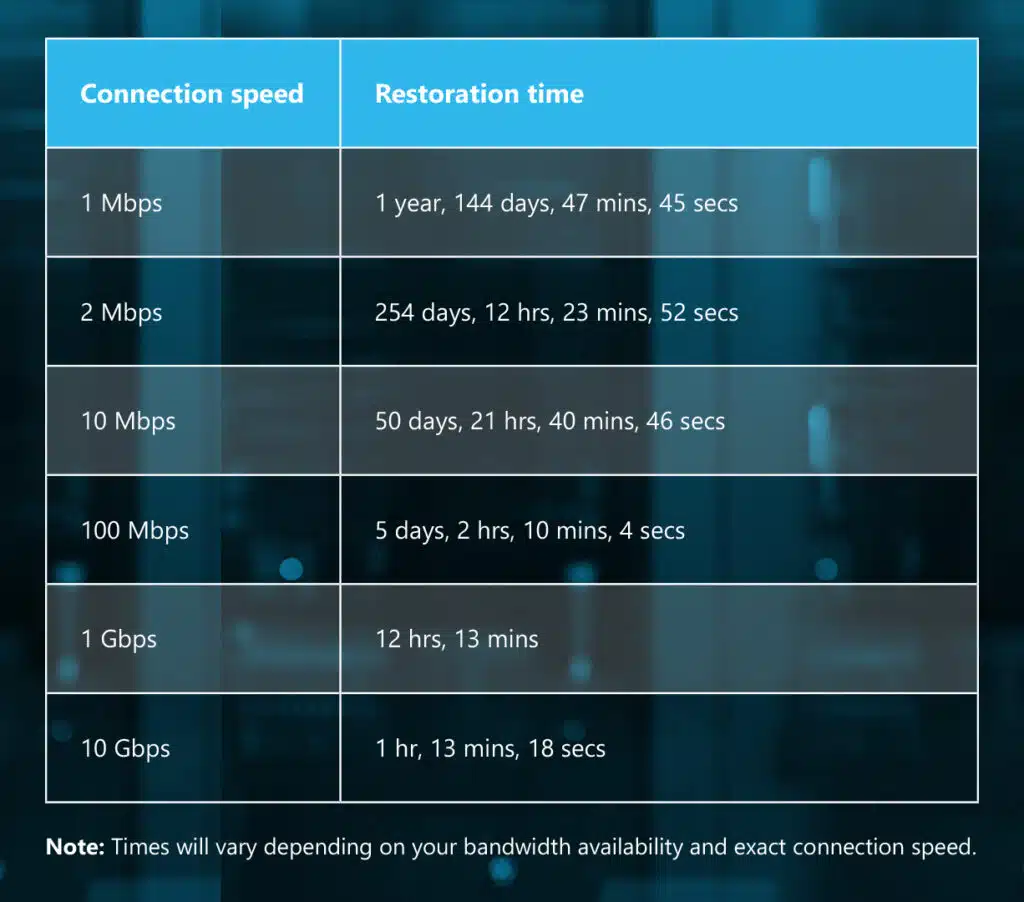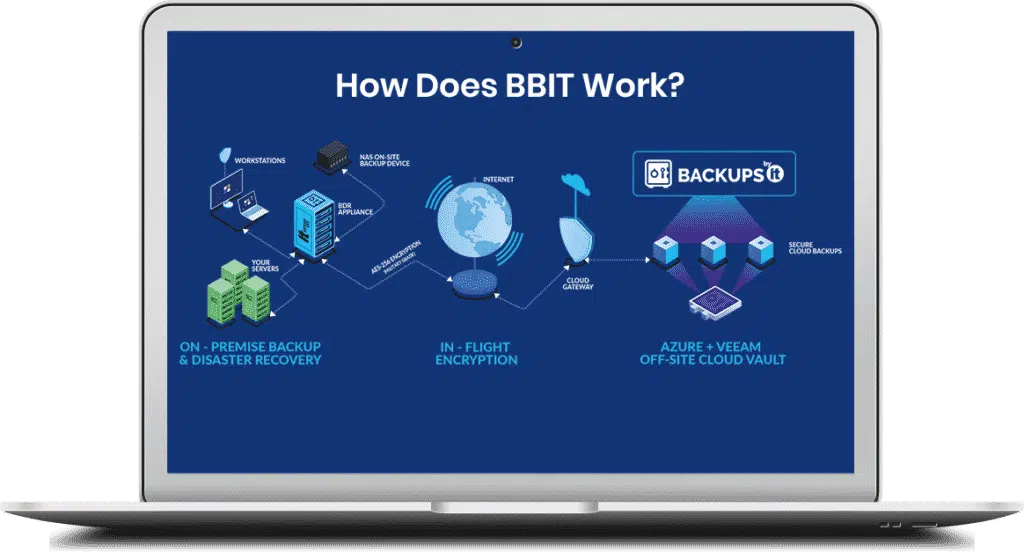Imagine walking into your home, flipping on your light switch, and – pop! The light bulb is burnt out, and you’re left in the dark. If you’re prepared, you have some spare bulbs you can use to bring back the light. If not, maybe you have at least one candle in a drawer somewhere that can help brighten the space a little.
This kind of situation is similar to a risk that many small businesses face when it comes to their data backup processes. Business owners already have plenty to worry about. Add to that events that might be coming, like a sudden loss of data, and it can become overwhelming.
We get it.
But not considering the best data backup can also lead to you just go with a cheap backup system, or even none at all. While in some cases a cheap backup system can be good enough, for most small businesses, it’s not, and there are several ways it can fail you when you need it most.
Businesses need to carefully consider their options when choosing a backup solution. That requires a bit of foresight and a bit of cynicism. Nobody wants to think about a natural disaster or cyberattack affecting their business, but being unprepared in either case is a disaster in and of itself.
As a business owner, you have to ask yourself, “If this situation happens, what will the response be? What steps are involved? How long will it take to recover? How much productivity will we lose? And how much will it cost us?”
Suddenly, the bigger picture becomes clearer. When you need your backup, you need it all, and you need it fast.
But before settling on a low-cost backup system, it’s important to understand these systems’ pitfalls and what they could mean for the priorities of your business. These shortcomings are crucial because when a system failure occurs, you need to know, “Will I have spare bulbs, or will I get left in the dark?”
1. File Sync is not a backup
With some cheap data backup solutions, businesses don’t truly have their data backed up. Instead, they have their files synchronized on a separate platform. This means that instead of having a full replication of crucial files in another physical space, they have a mirror-image of the data.
Did you accidentally delete a file? If so, your file-sync will also delete that file. Is a crucial file infected or corrupted? If so, that affected file is replicated on your file sync. Some free-mium backup systems, however, allow you to retain your deleted files in a recycle bin for up to 30 days.
Importantly, a quality backup system stores snapshot images of your file system that you can restore in case you need to. For an occasion when you realize a crucial file was lost weeks ago, you can often restore your system to a point beforehand and recover that file.
File sync should not be your entire backup solution, but can be a great addition to it. Synchronizing files is great if you lose your computer, but it will not help you in the case of file corruption or content edits that you did not intend.
The ideal backup strategy would add software that is dedicated to backing up, which allows you to decide how many revisions of a file that you keep, and gives you a separate path to restore from what you use day in and day out. This allows you to go back to what you want, not just what the sync tool allows.
2. Bandwith is expensive
Say the average small to mid-sized business stores approximately 5 TB of business-critical information in their backups. With a cheap backup option, businesses would have to upload all of this data through their internet connection.
For users who know their internet “speed,” they generally know their download speeds. But upload speeds are not often advertised up front by internet service providers (ISPs), and for good reason. High upload speeds are costly, and advertising those costs would not help ISPs sell them.
Because businesses often have asymmetrical internet speeds, it is not easy to realize how long it would take to simply upload their 5 TB of data to their cheap backup. Even with an upload speed of 100 Mb per second, it would take over 5 days to upload this data.
This lack of upload speed works both ways. When disaster strikes and your business needs to recover your backup from this service, you now rely on the service’s upload speed.
Consider all the overhead of development, marketing, support and distribution of a $3 per month unlimited backup software. Do you think they have the money to reinvest in fast upload speeds to get that data to you quickly?
Probably not.
You may get stuck downloading your data at 1 to 2 Mb per second, leaving you waiting roughly 8 to 9 months to get back up and running. That doesn’t sound feasible, does it?
3. Cyber threats
Getting caught without a well-rounded backup plan can be dangerous. While spending more on your backups does not guarantee that they will prevent cyber-attacks, having a properly licensed backup will give you more options in your planning.
There is no one-size-fits-all approach to backup or cybersecurity, so a lone, inexpensive backup won’t be, either.
In addition to an internet or cloud backup, consider a physical, offline backup. Keeping a fully separated, offline backup, or what’s called an “air-gapped backup,” will prevent any outside entity from being able to access your backup through the internet.
To learn how you can best prepare your business against the threat of ransomware, tune in to our cybersecurity webinar, “How to Prevent Ransomware Through Air Gapped Backups.”
4. Limited restoration testing
Perhaps the most important aspect of data backups is knowing that they will restore. Testing your backups can be extremely time-consuming, and most cheap backup software do not include programmatic restoration testing.
If a disaster strikes and your company’s backup fails to restore, there is no point in having it to begin with.
Brand reputation is not the only way that downtime can derail a business. Regulatory and compliance issues, as well as potential litigation, can also sprout up because of data loss. Testing verifies that all necessary information is captured, restored, and backed up successfully, with no corruption. There is no way to know of any potential hiccups in advance without testing your backups first.
While automated restoration testing is no match for a human-supervised restoration test, it is an important tool to greatly limit your exposure to data loss. Manual restoration testing can consume countless hours of your technical resources. Unless you plan to spend your weekends supervising the progress of your backups, you’ll want to take advantage of the automation provided in more robust tools or services.
Below is a list of tasks you should perform on every backup when following best practices for a verification test:
- Scan backup for viruses before restoration (can take from 30 minutes to 5+ hours)
- Restore backup in an isolated lab environment (30-60 minutes, if lab environment is already built)
- Scan restored backups for viruses after restoration (30 minutes to 5+ hours)
- Test integrity of data, applications, databases, and operating system (2-10 hours)
- Report on findings (time will vary)
In a best case scenario, automating a backup verification while following best practices can save you 3 1/2 hours each and every time.
Likely, the time it takes to verify your backups by hand will erase the cost savings promised by a cheap backup. Since 2006, IT Support Guys has invested well over $1 million in our proactive monitoring systems, which include monitoring and testing for backups.
With backups that are programmatically scheduled and run by ITSG, you’ll also have personnel dedicated to monitoring the tests, and we’ll know if there is an issue with your backups before you need them.
The Bottom Line on Cheap Backup Systems
Cheap backup systems can be useful as file-sharing and collaboration services, but they should not be used as a business’s primary backup solution. These options alone do not provide the necessary functions that protect businesses from data loss or cybercriminals, and they have the potential to cost more money over the long-term.
If you’re serious about backing up your company’s data, ensuring business continuity, consider a more comprehensive backup plan. IT Support Guys can help you decide which backup plans best fit your company’s needs. To learn more, check out our backup and disaster recovery services or reach out to us at 855-448-4897.







